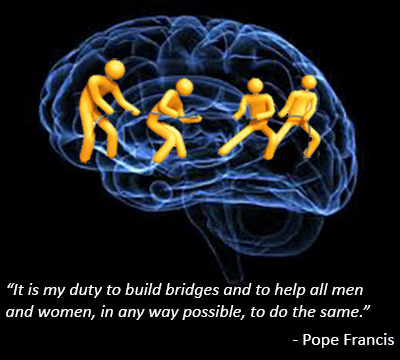These past weeks you have had the opportunity to experience how the media exacerbates the already existing tug of war in our heads. Politicians campaign for office with threatening messages about Mexicans and Muslims while Pope Francis invokes the Golden Rule entreating us to “treat others with the same…compassion with which we want to be treated.”
On the one hand, some politicians evoke fear and anger, which triggers the more primitive parts of the brain and its finely tuned, habitual self-protective mechanisms. The subtext reads, “It’s ‘us’ or ‘them;’ It’s a ‘dog eat dog world.’”
On the other, the Pope speaks to the “newer” parts of the brain inspiring hope and compassion. The subtext reads, “We are all in this together.” He asserts, “We must move forward together, as one, in a renewed spirit of fraternity and solidarity, cooperating generously for the common good.”
Perhaps the stakes in our meetings at work or in our communities are not as high as they are in Washington, D.C. or the Vatican, but they are still important. And it still matters which part of the brain we address because it affects the quality of our thinking, decision making and ability to work together.
The primitive parts of the brain do not need more words to stoke the fires there. They already have a “negativity bias” that is more attuned to perceiving threats than signs that we are safe.
Under threat, the survival mechanisms in the sub-cortical areas of the brain take charge and make it harder to access the cortical regions where we can make more conscious choices about what to think and say. It’s hard to stay conscious of this dynamic because protective/defensive mechanisms get triggered with lightening speed.
Here’s how it works in me. When I hear anyone, especially someone with a big megaphone, attack or malign individuals or an entire group of people I react, not against those who are being attacked but against the person doing the attacking. In other words, I mirror those doing the attacking by wanting to attack them back. In that moment, how am I different from them? I’m not.
For us to be able to effectively tackle the issues before us, we need to calm the survival mechanisms in the brain so that we notice when others are appealing to only a part of who we are and to build greater strength in the compassionate and wise parts in the cortical areas of it.
How do we do this? Here are a couple of possibilities.
When interacting with others pause now and then, expand your attention to include your breath and where you might be sensing it in your body. No one needs to know you are doing this. You are just taking a little break to rest and calm your mind.
Before a meeting, identify your “bridging” intention for it, one that has to do with how you want to interact with others, not just with what you want to get done. One intention could be to understand others with your heart not just your mind. For example, as you are listening ask yourself how the speaker might be feeling about what he is saying, or how it matters to him, or how she came to see the situation as she does. Such wondering might lead you to ask a question of genuine curiosity to help you better understand. For example, “How did you come to think of it this way?” Or, “Please help me understand. Why is this issue is important to you?”
We can turn the tug of war in our heads to a bridge that allows us to acknowledge what we are afraid of or what we are angry about (without being hijacked by it) while we also focus on what we want to create, perhaps the greatest common good, and how we might work with others to create it. This, in turn, allows us to build bridges among us.


A timely reminder to make the effort to understand and work with people who are different from us, rather than making them bad or wrong or stupid. Thank you.
Constructing bridges is a process that could take minutes, hours, or longer. Listening to understand, breathing, and understanding the impulse to fight are the brick & mortar.